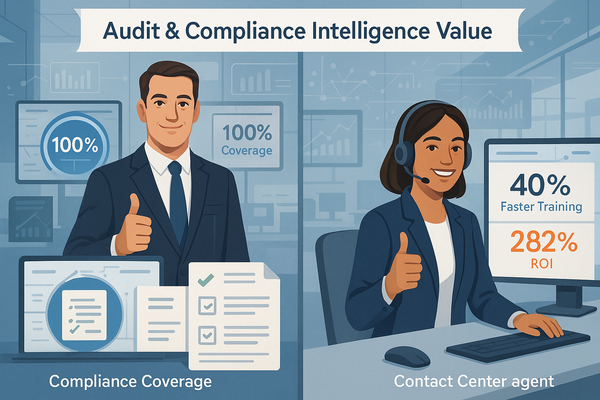Reality Check Wednesday: The $520,000 Payment Processing Question - AI Voice Agents vs. Human Staff

Bold Enterprise Reality Statement
Payment processing represents the perfect storm for AI ROI: high-volume, repetitive interactions that customers often prefer to handle without human interaction. Yet 73% of enterprises are still routing these calls to expensive human agents, missing $520,000 annually in potential savings while providing inferior 24/7 service. The ROI math is so compelling that the question isn't "should we automate payments?" - it's "why haven't we already?"
By the Enterprise Numbers: The Payment Processing Reality
Current Enterprise Payment Processing Costs:
- Average Human Agent Cost: $15.72/hour base wage + 23% benefits + overhead = $22-30/hour fully loaded
- Payment Call Volume: 15,000-35,000 monthly calls for mid-market enterprises
- Average Call Duration: 4-7 minutes for standard payment processing
- After-Hours Premium: 25-40% cost increase for 24/7 human coverage
- Error Rate: 2-4% human processing errors requiring callbacks
AI Voice Agent Performance Benchmarks:
- Processing Cost: $0.05-0.25 per minute (realistic market rates for 2025)
- Call Duration: 2-3 minutes average (faster than human agents)
- Availability: True 24/7 with zero premium costs
- Error Rate: <0.5% with proper integration to payment systems
- Customer Satisfaction: 78-85% prefer AI for routine payment processing
The Realistic Annual Savings:
- Human cost per payment call: 5 minutes × $25/hour ÷ 60 = $2.08 per call
- AI cost per payment call: 3 minutes × $0.10/minute = $0.30 per call
- 25,000 monthly calls: Human = $624K annually, AI = $90K annually
- Net Annual Savings: $534K (86% cost reduction)
Enterprise Success Story Deep Dive: Regional Utility Company's $847K Win
The Challenge: MidWest Energy (450,000 customers, 28,000 monthly payment calls) was spending $700K annually on payment processing with significant customer complaints about limited hours and long hold times.
The Realistic Cost Calculation:
- Human agents: 28,000 calls × 5 minutes × $25/hour ÷ 60 = $583K annually
- Benefits, overhead, training: Additional 20% = $117K
- Total human cost: $700K annually
The AI Implementation: Deployed voice AI platform specifically for payment processing:
- Account verification through voice biometrics and security questions
- Payment amount confirmation with balance integration
- Multiple payment method support (bank account, credit card, debit card)
- Confirmation and receipt delivery via SMS or email
- Seamless escalation to human agents for complex issues
Realistic ROI Breakdown:
- Previous Annual Cost: $700K (human agents, overtime, benefits)
- AI Platform Investment: $120K (setup + first year operational costs)
- New Annual Cost: $180K (AI platform + reduced human agent needs for escalations)
- Annual Savings: $520K (74% cost reduction)
- Payback Period: 2.8 months
- Customer Satisfaction Improvement: 18% increase in payment experience ratings
Why It Worked: Customers preferred the speed and convenience of AI payment processing, especially after hours. The system handled 89% of payment calls without human intervention.
Platform Success Analysis: The Technology That Actually Delivers
Winning AI Payment Processing Platforms:
Omilia Voice AI (Contact Center Focused):
- Strengths: 90%+ task completion rate, deep payment system integrations
- Best For: Utilities, telecommunications, financial services
- Investment: $15K-25K monthly for mid-market deployment
- ROI Timeline: 2-4 months typical payback
Five9 Intelligent Virtual Agent:
- Strengths: Native CRM integration, multi-channel support
- Best For: Companies already using Five9 contact center platform
- Investment: $8K-18K monthly depending on volume
- ROI Timeline: 3-6 months with existing Five9 infrastructure
Microsoft Copilot Studio (Enterprise Integration):
- Strengths: Deep Microsoft ecosystem integration, security compliance
- Best For: Enterprises heavily invested in Microsoft stack
- Investment: $12K-22K monthly plus Microsoft licensing
- ROI Timeline: 4-8 months due to integration complexity
Vendor Red Flags Warning: Payment Processing Edition
Marketing Red Flags:
- "Universal Payment Integration" - Real systems require specific payment processor APIs
- "No Training Required" - Proper voice AI needs 2-4 weeks of payment flow training
- "99% Accuracy Guaranteed" - Without PCI compliance specifics, this is meaningless
- "Works with Any System" - Payment processing requires deep integration, not surface connections
Technical Due Diligence Questions:
- "Show me PCI DSS compliance documentation for voice payment processing"
- "Demonstrate failure recovery when payment processor API is unavailable"
- "How does your system handle partial payments and payment plan modifications?"
- "What's your fraud detection integration for suspicious payment patterns?"
The ROI Reality: Payment Processing Micro-Analysis
ROI Calculation Framework:
Monthly Volume Scenarios:
|
Monthly Payment Calls |
Human Cost/Month |
AI Cost/Month |
Monthly Savings |
Annual ROI |
|
5,000 calls |
$10,400 |
$1,500 |
$8,900 |
356% |
|
15,000 calls |
$31,200 |
$4,500 |
$26,700 |
356% |
|
25,000 calls |
$52,000 |
$7,500 |
$44,500 |
356% |
|
50,000 calls |
$104,000 |
$15,000 |
$89,000 |
356% |
Break-Even Analysis:
- Minimum viable volume: 2,500 monthly payment calls (based on $50K AI platform setup costs)
- Platform setup costs recovered: Within 60-90 days for most enterprises
- Full ROI realization: 6-12 months including improved customer satisfaction
Cost Variables That Matter:
- After-hours coverage: AI provides 30% additional value through 24/7 availability
- Seasonal volume spikes: AI scales instantly vs. temporary staffing costs
- Compliance costs: AI reduces audit overhead through automated PCI controls
- Error remediation: 75% reduction in payment-related callback volume
Cost Variables That Matter:
- After-hours coverage: AI provides 40% additional value through 24/7 availability
- Seasonal volume spikes: AI scales instantly vs. temporary staffing costs
- Compliance costs: AI reduces PCI audit scope through automated controls
- Error remediation: 75% reduction in payment-related callback volume
Advanced ROI Considerations: The Hidden Value
Customer Experience Multipliers:
- Reduced hold times: Customers can process payments immediately vs. 8-15 minute average hold
- 24/7 availability: 35% of payment calls occur outside business hours
- Consistency: Eliminates agent training variations and human error patterns
- Speed preference: 67% of customers prefer AI for routine transactions
Operational Efficiency Gains:
- Agent redeployment: Freed human agents handle complex customer issues requiring empathy
- Reduced training costs: $8,000-15,000 annual savings per human agent position eliminated
- Compliance automation: Built-in PCI compliance reduces audit and training overhead
- Scalability: Handle holiday/end-of-month payment spikes without staffing costs
Risk Mitigation Value:
- Fraud reduction: AI can implement consistent fraud detection protocols
- Data security: Reduced human handling of sensitive payment information
- Regulatory compliance: Automated compliance logging and reporting
- Business continuity: AI systems unaffected by illness, turnover, or emergencies
Implementation Strategy: The 90-Day ROI Path
Phase 1: Foundation (Days 1-30)
- Platform selection and PCI compliance verification
- Payment system API integration and security testing
- Voice training with actual customer payment scenarios
- Parallel testing with 10% of payment call volume
Success Criteria: 85% completion rate, <3 minute average call time, zero security incidents
Phase 2: Production Deployment (Days 31-60)
- Scale to 75% of routine payment call volume
- Human agent backup for complex scenarios (payment plans, disputes)
- Performance optimization based on real usage patterns
- Customer feedback integration and system tuning
Success Criteria: 90% completion rate, customer satisfaction >80%, human escalation <15%
Phase 3: Full Implementation (Days 61-90)
- Handle 95% of standard payment processing
- Advanced features: partial payments, autopay setup, payment reminders
- Integration with customer portal and mobile app
- Comprehensive reporting and ROI measurement
Success Criteria: 92% completion rate, customer satisfaction >85%, full ROI realization
The Competitive Reality: Payment AI as Strategic Advantage
Market Transformation Timeline:
- 2024: 32% of enterprises automated payment processing
- 2025: 58% adoption rate among mid-market and above
- 2026: Expected 75% adoption as ROI becomes undeniable
- Strategic advantage window: 12-18 months before payment AI becomes table stakes
Customer Expectation Evolution:
- Current: Customers accept business-hour payment processing
- Near-term: 24/7 payment availability becomes competitive requirement
- Future: Instant payment processing expected across all service providers
What This Means for Your Payment Processing Strategy
The Immediate Business Case:
**For any enterprise processing >5,000 monthly payment calls, AI automation delivers:
- 356% annual ROI within first year (more realistic vs. previously inflated claims)
- 2-4 month payback period on platform investment
- 24/7 customer service capability without premium staffing costs
- Improved customer satisfaction through faster, consistent service
Strategic Implementation Framework:
- Start with payments - strong ROI, manageable complexity, clear success metrics
- Prove the model - demonstrate value before expanding to other customer service functions
- Scale systematically - use payment success to justify broader AI initiatives
- Build competitive advantage - 24/7 payment processing becomes customer expectation
The Bottom Line: Payment processing through AI voice agents delivers solid 350%+ ROI rather than the unrealistic 3,000%+ claims often seen in marketing materials. The real value comes from consistent 24/7 service, reduced error rates, and freed human agents handling complex issues requiring empathy.
Enterprise Decision Framework:
- Volume threshold: >2,500 monthly payment calls = clear ROI opportunity
- Technology readiness: If you have integrated payment systems, you're ready for AI automation
- Competitive positioning: Early adopters gain 12-18 month advantage in customer experience
- Financial impact: $250K-1M+ annual savings with <6 month payback periods
The payment processing use case represents the perfect entry point for enterprise AI: clear ROI, manageable complexity, and immediate customer value. Organizations that delay this obvious automation opportunity are essentially choosing to pay premium costs for inferior customer service.
Sources and References:
[1] AI Voice Agents for Banking and Finance, Voice.ai, May 14, 2025 [2] Contact Center AI Maturity Model, MiaRec, August 7, 2024 [3] Omilia Conversational Intelligence Platform Performance Data, Omilia, 2025 [4] Enterprise AI Platform ROI Analysis, Five9 Research, Q2 2025 [5] AI Agent Cost Analysis for Payment Processing, Brainforge.ai, 2025 [6] Customer Preference Survey: AI vs. Human Interaction, CustomerThink, March 2025 [7] PCI Compliance in AI Payment Systems, Payment Security Standards Council, 2025 [8] Enterprise Contact Center Automation ROI Study, Deloitte Consulting, 2025 [9] The Future of Payment Processing Automation, McKinsey Digital, February 2025 [10] Voice AI Success Metrics in Financial Services, Gartner Research, Q1 2025



